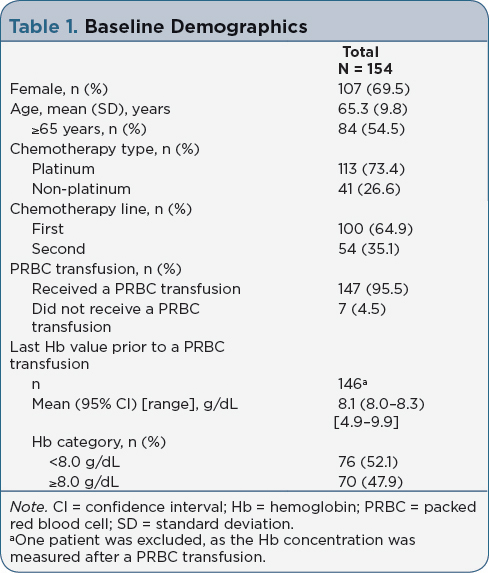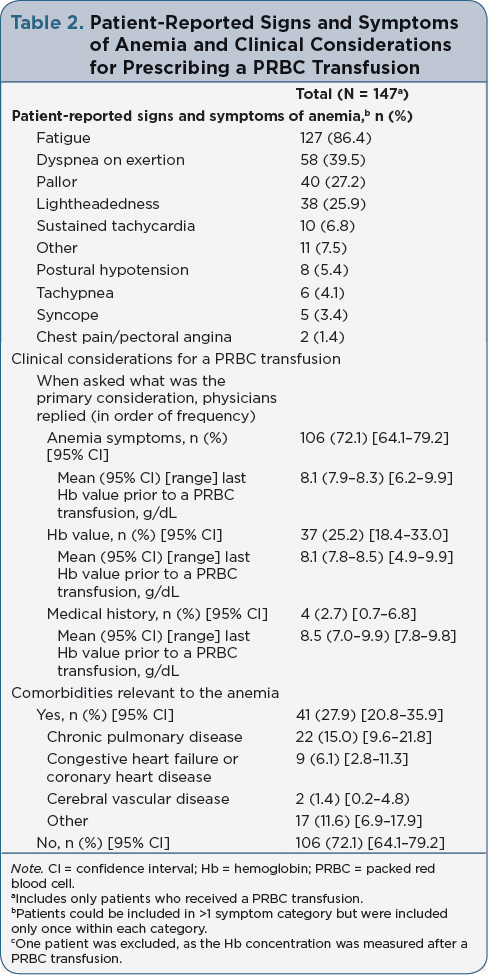Abstract
Background: The decision to prescribe a packed red blood cell (PRBC) transfusion in patients with chemotherapy-induced anemia includes assessment of clinical features such as the patient’s cancer type and treatment regimen, severity of signs and symptoms of anemia, and presence and severity of comorbidities. Here, we sought to examine contemporary transfusion practices in patients receiving myelosuppressive chemotherapy for nonmyeloid cancer. Methods: Eligible patients were ≥18 years of age, had nonmyeloid cancer, were receiving first- or second-line myelosuppressive chemotherapy, had baseline hemoglobin (Hb) ≤10.0 g/dL, and were planned to receive ≥1 PRBC transfusion. Key exclusion criteria were receipt of an erythropoiesis-stimulating agent within 8 weeks prior to screening and/or chronic renal insufficiency. The study ran from 30-Sep-2014 to 31-Oct-2015. Data were collected from patients’ medical records, laboratory values, and physician/provider questionnaires to determine considerations for transfusions. The proportions of primary clinical considerations leading to PRBC transfusions and 95% exact binomial confidence intervals (CIs) were estimated. Results: The study enrolled 154 patients at 18 sites in the US. Of these, 147 (95.5%) received a PRBC transfusion (Table 1). Mean (95% CI) last Hb value before PRBC transfusion was 8.1 (8.0–8.3) g/dL. Fatigue was the most common patient-reported symptom affecting the decision to prescribe a PRBC transfusion (94 [64.4%] patients), followed by dyspnea on exertion (24 [16.4%] patients) (Table 2). The most frequently reported primary clinical consideration for prescribing a PRBC transfusion was anemia symptoms (106 [72.1%] patients; mean Hb, 8.1 g/dL), followed by Hb value (37 [25.2%] patients; mean Hb, 8.1 g/dL) and medical history (4 [2.7%] patients; mean Hb, 8.5 g/dL). Overall, 70 (47.9%) patients received a transfusion at Hb ≥8.0 g/dL. Consistent results were observed when data were analyzed by age ( <65 vs ≥65 years), sex, tumor type, comorbid conditions, chemotherapy type/line, and site type (academic vs nonacademic). Comorbid medical conditions were reported in 41 (27.9%) patients. Only 9 (6.1%) patients had underlying cardiovascular disease. Conclusion: In this study, the primary clinical considerations for prescribing a PRBC transfusion were anemia symptoms in 72.1% of patients, Hb value in 25.2% of patients, and medical history in 2.7% of patients; 47.9% (70 patients) received a transfusion at Hb ≥8.0 g/dL. Results show that multiple clinical factors, not just the Hb value, were used in the decision to prescribe PRBC transfusions in this patient sample.









